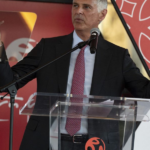For most Americans, there’s less reason than ever to worry about finding chargers to fuel up an electric vehicle. But charging worries remain a top hesitation for potential buyers, second only to sticker shock.
Those concerns linger even as fast chargers multiply. More than 12,000 have been added within a mile of U.S. highways and interstates just this year, an Associated Press analysis of data from the National Renewable Energy Laboratory shows. That’s about a fifth of quick-charging ports now in operation.
That’s a perception Daphne Dixon, leader of a nonprofit that advocates for clean transportation, has been trying to fight. She has taken a coast-to-coast road trip in an EV each year since 2022. Always sporting hot pink and waving a bubblegum checkered race flag to match, Dixon posts snapshots of the charging experience along her 3,000-mile (4,828-kilometer) route, hoping to “bust” Americans’ anxiety about range and charging.
Dixon said she has repeatedly found that “range anxiety is stuck in people’s heads,” even though the gap in price between gas and electric cars is closing and more chargers are being installed.
“A lot of people still fear that there’s not enough chargers, but what they’re not seeing is that chargers are being put in every single day,” she said.
Traveling on Interstate 80, the longest American interstate, a driver will encounter few stretches that are more than 10 miles (16 kilometers) away from a fast charger, all the way from New York City to Des Moines. Out West, coverage is spottier. But the miles on I-80 covered by fast chargers has increased by 44% since 2021, the AP analysis found.
Drivers would have a similar experience on other major roads. Nearly 70% of the combined length of the 10 longest interstates is within 10 miles of a fast charger — up from about half just five years ago.
In Dixon’s home state of Connecticut, drivers still fret about charging. In the fall, Dixon takes a shorter trip along Route 7, a scenic drive full of river bends and antiques barns. Fast chargers are scarce along the route, as they still are in many rural parts of the U.S.
The only plug in Kent, a town about 50 miles (80 kilometers) north of Norwalk, is an aging machine at town hall that’s long been defunct, said Lynn Mellis Worthington, chair of the town’s sustainability team.
Mellis Worthington and her husband considered an EV when they replaced their 15-year-old Pontiac Vibe this year. She said prices for cars with enough range to make her husband feel comfortable with his commute were still too high. So despite her high hopes of going full electric, they went with a hybrid instead.
“Our next car will definitely be an EV,” she said.
Electric vehicles held about 8% of the U.S. market share in 2024, up from 1.9% five years prior, according to data from Atlas Public Policy.
In the long run, owning an EV may be cheaper due to lower maintenance costs and the lower price of electricity compared to fuel in many places, said Daniel Wilkins, a policy analyst at Atlas Public Policy.
Still, “everyday Americans are focused more on the sticker price upfront,” he said.
Warner has one EV and one plug-in hybrid vehicle. He’s taken the EV, a Chevy Bolt with a roughly 250-mile (402 kilometer) range per charge, on a 400-mile (643-kilometer) trip to Maine twice since he bought it in 2022.
“The first trip, I turned the heat off. I made sure I drove 65,” Warner said. “The second time I just drove normally and had no problem.”









